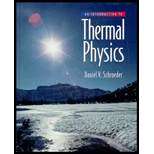
An Introduction to Thermal Physics
1st Edition
ISBN: 9780201380279
Author: Daniel V. Schroeder
Publisher: Addison Wesley
expand_more
expand_more
format_list_bulleted
Question
Chapter B.3, Problem 13P
To determine
To Derive: The formula for Stirling’s approximation
Expert Solution & Answer
Want to see the full answer?
Check out a sample textbook solution
Students have asked these similar questions
Please help to prove this to be true
Prove that the first three Legendre polynomials satisfy the Legendre
equation when m = 0.
(dA)T,V >0
Chapter B Solutions
An Introduction to Thermal Physics
Ch. B.1 - Sketch an antiderivative of the function ex2.Ch. B.1 - Prob. 2PCh. B.1 - Prob. 3PCh. B.1 - Prob. 4PCh. B.1 - Prob. 5PCh. B.1 - Prob. 6PCh. B.2 - Prob. 7PCh. B.2 - Prob. 8PCh. B.2 - Prob. 9PCh. B.3 - Prob. 10P
Ch. B.3 - Prob. 11PCh. B.3 - Prob. 12PCh. B.3 - Prob. 13PCh. B.4 - Prob. 14PCh. B.4 - Prob. 15PCh. B.4 - Derive a formula for the volume of a d-dimensional...Ch. B.5 - Derive the general integration formulas B.36Ch. B.5 - Prob. 18PCh. B.5 - Prob. 19PCh. B.5 - Evaluate equation B.41 at x=/2, to obtain a famous...Ch. B.5 - Prob. 21PCh. B.5 - Prob. 22P
Knowledge Booster
Similar questions
- A (nonconstant) harmonic function takes its maximum value and its minimum value on the boundary of any region (not at an interior point). Thus, for example, the electrostatic potential V in a region containing no free charge takes on its largest and smallest values on the boundary of the region; similarly, the temperature T of a body containing no sources of heat takes its largest and smallest values on the surface of the body. Prove this fact (for two-dimensional regions) as follows: Suppose that it is claimed that u(x, y) takes its maximum value at some interior point a; this means that, at all points of some small disk about a, the values of u(x, y) are nolarger than at a. Show by Problem 36 that such a claim leads to a contradiction (unless u = const.). Similarly prove that u(x, y) cannot take its minimum value at an interior point.arrow_forwardI have been able to do this with derivatives but I can't figure out how to do this with definite integralsarrow_forwardUse a computer to reproduce the table and graph in Figure 2.4: two Einstein solids, each containing three harmonic oscillators, with a total of six units of energy. Then modify the table and graph to show the case where one Einstein solid contains six harmonic oscillators and the other contains four harmonic oscillators (with the total number of energy units still equal to six). Assuming that all microstates are equally likely, what is the most probable macrostate, and what is its probability? What is the least probable macrostate, and what is its probability?arrow_forward
- Find the moments Ma, My and the mass m, of the triangular lamina defined by the vertices (0,0), (0,3) 1 and (9,3). The density function is p(æ, y) least significant digits. (xy)? . Provide an exact answer or answer accurate to at M, = %3D My = m =arrow_forwardConsider a system of two Einstein solids, A and B, each containing10 oscillators, sharing a total of 20 units of energy. Assume that the solids areweakly coupled, and that the total energy is fixed. How many different microstates are available to this system?arrow_forwardStarting with the equation of motion of a three-dimensional isotropic harmonic ocillator dp. = -kr, dt (i = 1,2,3), deduce the conservation equation dA = 0, dt where 1 P.P, +kr,r,. 2m (Note that we will use the notations r,, r2, r, and a, y, z interchangeably, and similarly for the components of p.)arrow_forward
- Consider N identical harmonic oscillators (as in the Einstein floor). Permissible Energies of each oscillator (E = n h f (n = 0, 1, 2 ...)) 0, hf, 2hf and so on. A) Calculating the selection function of a single harmonic oscillator. What is the division of N oscillators? B) Obtain the average energy of N oscillators at temperature T from the partition function. C) Calculate this capacity and T-> 0 and At T-> infinity limits, what will the heat capacity be? Are these results consistent with the experiment? Why? What is the correct theory about this? D) Find the Helmholtz free energy from this system. E) Derive the expression that gives the entropy of this system for the temperature.arrow_forwardPlease no written by hand solutionarrow_forwardPlease calculate and simply this integralarrow_forward
arrow_back_ios
SEE MORE QUESTIONS
arrow_forward_ios
Recommended textbooks for you
 Classical Dynamics of Particles and SystemsPhysicsISBN:9780534408961Author:Stephen T. Thornton, Jerry B. MarionPublisher:Cengage Learning
Classical Dynamics of Particles and SystemsPhysicsISBN:9780534408961Author:Stephen T. Thornton, Jerry B. MarionPublisher:Cengage Learning

Classical Dynamics of Particles and Systems
Physics
ISBN:9780534408961
Author:Stephen T. Thornton, Jerry B. Marion
Publisher:Cengage Learning